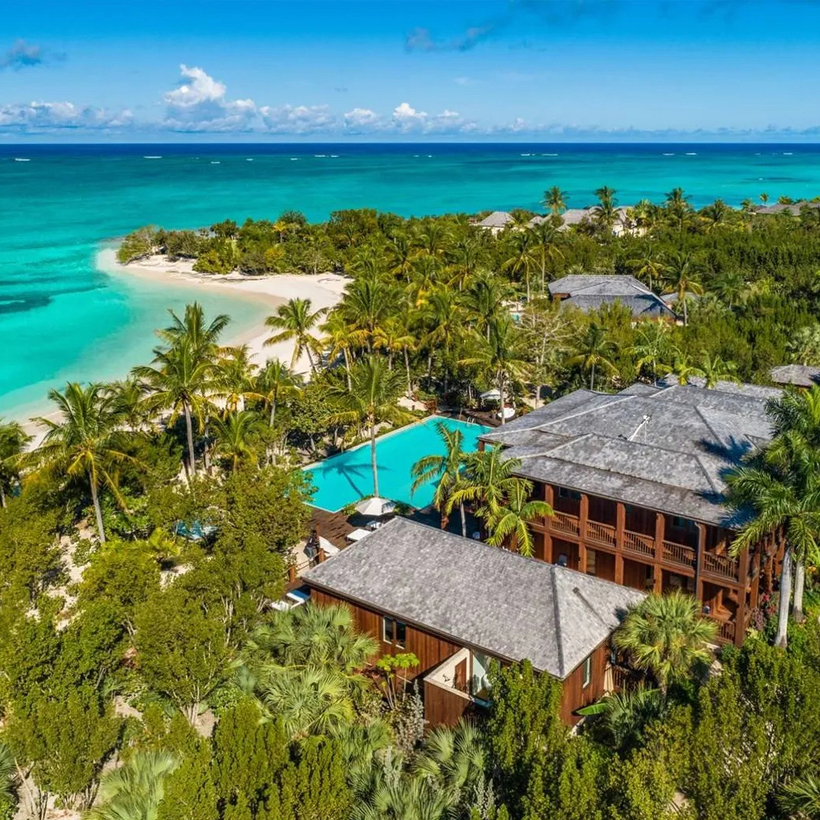In many parts of Turks and Caicos, an idyllic archipelago in the Caribbean, the sound of jackhammers is nearly constant. It hasn’t deterred visitors.
Take the southeast side of Providenciales island, where Windward Development is building South Bank, a 31-acre community on Long Bay Beach. Though construction on its 46 sleek, clean-lined villas and townhomes won’t be complete for months, some South Bank owners have already moved in, despite the presence of bulldozers and the lack of amenities such as a gym, spa, or restaurant. (They are coming soon, all designed by Thurstan, a firm founded by Soho House’s former design director.)
“Over Christmas, we had owners staying in seven of our lagoon villas,” says Ingo Reckhorn, a director at Windward Development, referring to a group of blindingly white four-bedroom homes clustered around a turquoise-colored, man-made lagoon. “Every night, I got a picture from one of them: ‘Look at this sunset!’”

Only one stand-alone home remains available for sale: a six-bedroom, oceanfront “dune villa,” for $14.5 million. “Our sales have far surpassed our expectations,” says Reckhorn. “We sold a similar home for $6 million a year ago,” he explains. “It would probably go for $8 million if it were to go back out on the market now.” An unlikely prospect.
There are many reasons to home in on Turks and Caicos. There’s the sea, a hypnotic array of blues. There’s the sand, white, soft as talc. There’s the food, fish caught six feet from your table and prepared before your eyes. But the main reason is real estate. Specifically, beachfront new construction from which you can work, play, or retire if you’re lucky—and liquid—enough to scoop it up.
Life’s a Beach
The islands have long been overlooked, what with their more well-known neighbors to the west (the Bahamas) and south (the Dominican Republic, Puerto Rico, the British Virgin Islands, and the many paradisiacal ports that follow).
Recently, Turks and Caicos’s status has been boosted by the celebrities who take over gated compounds on the islands, including Drake, who sometimes shows up at a local hookah bar, Aziza, and has been known to hand out stacks of cash to adoring fans. (This week, Drake’s Nike line, NOCTA, released Turks and Caicos Spring Break, a clothing collection inspired by the islands.) Many Kardashians can’t seem to turn a year older without submerging themselves in the blue waters off the islands’ coasts. Several N.F.L. players went to the islands to celebrate after the Super Bowl, explains Boysie Taylor, a Turks native and driver with Kars V.I.P. Services.

Past and current homeowners who belong to the three-comma club include the insurance impresarios Mark and Robyn Jones (who bought a compound previously owned by Bruce Willis) and Tim Blixseth, a co-founder of the Yellowstone Club and frequenter of bankruptcy court. Multi-millionaires are more common: Donna Karan, Christie Brinkley, Keith Richards.
Drake sometimes shows up at a local hookah bar and has been known to hand out stacks of cash to adoring fans.
Longtime residents know the advantages of life on this particular set of islands. The Providenciales airport, unlike the one on St. Barth’s, is big enough to accommodate a commercial airliner. Several major cities on the Eastern Seaboard offer daily nonstop flights to Providenciales. Direct flights from London are coming soon. Air Drake, the Toronto-born rapper’s customized Boeing 767, makes frequent appearances on the runway.
“Our price points are lower than the Caymans or St. Barth’s,” says Atilla Cimsit, South Bank’s general manager. “If you’re from New York, the flight here takes about as long as the flight to Miami—or the drive to the Hamptons. ”

Perhaps the No. 1 advantage for buyers: a lack of taxes, including on income, property, inheritance, corporate profits, and capital gains. Plus: the official language, English, and the currency, U.S.D. “We are a British overseas territory,” Reckhorn says. “The British King is our highest government official, which can be a source of comfort.”
Britain was quick to offer aid when Hurricanes Irma and Maria hit, in 2017; it expedited testing kits and vaccines during the coronavirus pandemic. According to Reckhorn, the islands’ use of British common law also makes it “a very safe transactional environment” for real-estate investment, “versus some other destinations like the Bahamas, where they’ve gone independent.”
While Taylor says some of the new developments “look like Dubai,” he’s thrilled by the uptick of tourists and new residents. He even canceled his Valentine’s Day vacation to take a chauffeur job on the island. “Can’t let [this] client down,” he explains. “With the money I make from this gig, I’ll buy my wife something bigger and better.”
Other locals aren’t as pleased. “Some guests expect New York fast,” says one restaurant server. “We don’t work like that.”

The archipelago offers tiers of exclusivity endemic to every place that caters to the elite. Take Pine Cay, a private island off the coast of Providenciales that, 50 years ago, became a haven for those seeking ultimate seclusion. With only 38 homes and a handful of hotel rooms, deeds rarely change hands.
Perhaps the No. 1 advantage for buyers: a lack of taxes, including on income, property, inheritance, corporate profits, and capital gains.
“We have one coming on the market because the owner passed away,” says Sandrine Langlade, Pine Cay’s assistant general manager. “It’s unfortunately not something that the children can afford to keep, which can happen.” (The home is going for $3.5 million, and includes private water access and a view of the mangroves.)
Taylor has a motto: “Don’t come to Turks if you don’t have money.” The average hotel-room rate is $1,000 a night. Cocktails cost what they would in New York—$20 for an espresso martini. Most visitors don’t seem to mind. Grace Bay Resorts, one of the islands’ leading hospitality firms, saw revenues of $60 million last year, more than double what they were in 2020.
“Our occupancy used to taper off in the summer,” says Karen Whitt, of the Hartling Group, the developer behind the Shore Club, an airy amalgamation of resort and villas. “Last year, we didn’t have a down season.”

The Hartling Group is building a residential community on a cliff reminiscent of the Amalfi Coast and adding 25 acres to the existing Shore Club. In the view of C.E.O. Stan Hartling, the return on investment is all but written.
“This is not the borrowing demographic,” says Hartling. “Someone comes and looks at a $2 million condo. They not only have the $2 million, they’ve got another $2 million. It’s like buying a nice watch—you want to put money in something that will be good in 5, 10, 15 years.” Call it the Rolex of archipelagoes.
Certain things can’t be scaled, like the daily special at Caribbean Cuisine, a homey restaurant near the Providenciales airport whose curried chicken and roti deserve Michelin stars. Gowri Ramprasad, the chef and proprietor, cooks only a limited amount of curry every day. When she’s out, she’s out.
“You gotta move if you want to get your piece,” says Taylor. You may be on island time, but the clock’s still ticking.
Sheila Yasmin Marikar is a Los Angeles–based writer

